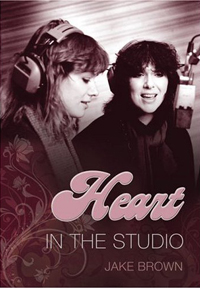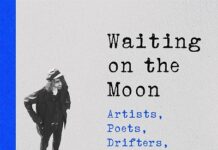If you’ve ever wondered about the sonic perfection behind timeless classic
rockers like “Magic Man” and “Barracuda,” your ship
has come in. Heart In The Studio, a new book written by Jake
Brown and published by ECW Press, digs deep into the nitty gritty of the writing,
recording and studio wizardry that went into every Heart album.
Lead by sisters Ann and Nancy Wilson, Heart scaled the male-dominated mountain
of hard rock in the 70s and 80s and came out a winner with over 30 million records
sold. Brown goes to the very beginning, chronicling the girls’ growth
as musicians, singers and songwriters, with an emphasis on their influences
(mainly the Beatles and Led Zeppelin). As teenagers, Ann and Nancy — along
with friend Sue Ennis — spent countless hours singing and playing guitars.
This would nurture a special and strong creative bond that went onto produce
numerous Heart classics.
Then, in Seattle, post-Hendrix and pre-grunge, Heart was born. Ennis pushes
the narrative forward with memories of how Ann was playing the bar band circuit,
the girls’ fascination with writers like Kafka and Dostoevsky, as well
as their musical heroes, and the birth of Heart. Producer Mike Flicker, another
frequent speaker, explains how when he first saw Heart, it was Ann Wilson and
a bunch of guys.
Nancy took the folk music route before being persuaded to join her sister.
Nancy’s acoustic tendencies transformed the band, and the sisters signed
with Flicker’s Mushroom Records. Together, with Flicker, arranger/engineer/future
band member Howard Leese, guitarist Roger Fisher, bassist Steve Fossen and an
“ever-changing line-up of drummers,” Ann and Nancy recorded Dreamboat
Annie and Heart’s star took an immediate rise.
At this juncture in the book, each chapter focuses squarely on each of the
band’s albums. Flicker, who produced the first five Heart albums, goes
into great detail about the process, breaking down each microphone and instrument
used for any track that matters, and lavishing praise upon Ann’s incredible
voice and Nancy’s role as harmonizer, co-songwriter and acoustic guitarist.
Leese deservedly draws a lot of credit for helping Heart develop musically
and prosper. It’s interesting to read how he, not Fisher, was responsible
for many of the guitar leads on those early albums. Fisher gets his due for
his creativity and contributions to various songs (and Fossen and the band’s
first permanent drummer Michael Derosier pull a scant mention or two), but it’s
a shame he wasn’t interviewed and given a chance to explain his part in
the early days of Heart. Then again, his departure is somewhat downplayed, so
perhaps his memories of Heart aren’t so favorable.
Truth be told, if you’re looking for dirt on the Wilson sisters or anyone
from Heart’s personnel, this isn’t the book to read. But if you’re
a recording buff and need to know what kind of microphone was used on the bass
drum for “Barracuda,” then this is your new bible. Even then, it
isn’t as much a high tech guide as it is the story of a typical band experiencing
the ebb and flow of the topsy-turvy music business.
One of the more fascinating periods in the history of Heart is the 80s when
they recruited new hot-shot players (bassist Mark Andes and drummer Denny Carmassi)
and world-class producers (Ron Nevison, Ritchie Zito, Keith Olson) who insisted
on reshaping the band’s sound and using outside songwriters. That along
with the big-hair image proved to be, while financially satisfying, a bit of
a rough patch for the Wilsons. Ann Wilson says that the compromises Heart made
in those days, “offended us actually…” explaining how MTV
and the video age placed unreasonable demands on women with “fake fingernails
and corsets and all the stuff that was big in the 80s.” Brown politely
skirts the issue of Ann’s weight problems, while continually extolling
the virtues of her incredible voice.
The 90s onward found the Wilson sisters settling into their role as veteran
pioneers. It also gave the girls to time to breathe, reflect, have families
and eventually return to their roots. Brown touches on the Wilson’s side
group, the Lovemongers, before landing on an overly long chapter on the most
recent Heart album from 2004, Jupiter’s Darling.
For this record, Heart sported a whole new lineup, aside from the Wilsons,
including guitarist Craig Bartok. Bartok dominates the chapter with lengthy
expositions on the songwriting and recording of the album. Brown would have
served the book better had he cut the chapter and peppered it with a few more
Ann or Nancy quotes. Nevertheless, Bartok, like every other producer and commentator
interviewed for the book, thinks the Wilsons are brilliant in every possible
way, echoing the shared theory that their singing harmonies attain that special
blend genetically (which makes sense when you think of other singing siblings
like the Every Brothers). Point taken.
The book also touches on Ann and Nancy side projects, notably on the former’s
2007 solo covers album, Hope & Glory, which includes duets
with Gretchen Wilson, Wynona Judd and Elton John. The final chapter speculates
on the group’s future, suggesting their next album might be something
more conceptual, akin to Pink Floyd’s The Dark Side Of The Moon.
That could be interesting.
As should be expected there’s a fair share of rare photos (mostly of
the Wilson sisters — alone, together, band promo shots, or in the studio
with their dogs) and a couple minor inaccuracies (Fleetwood Mac’s Rumours
did not come out three years after Dreamboat Annie and Jimmy
Iovine did not produce John Lennon’s Double Fantasy).
For the most part, however, this is a cool and calm read any Heart or music
fan will enjoy and savor. Pushed along with extensive quotes from most of the
key players, alternating with a mixed bag of facts, figures, tidbits and whatnot,
Heart In The Studio is the most authoritative tomb out there
on Heart, the biggest female-led hard rock band of all-time.
~ Shawn Perry




















